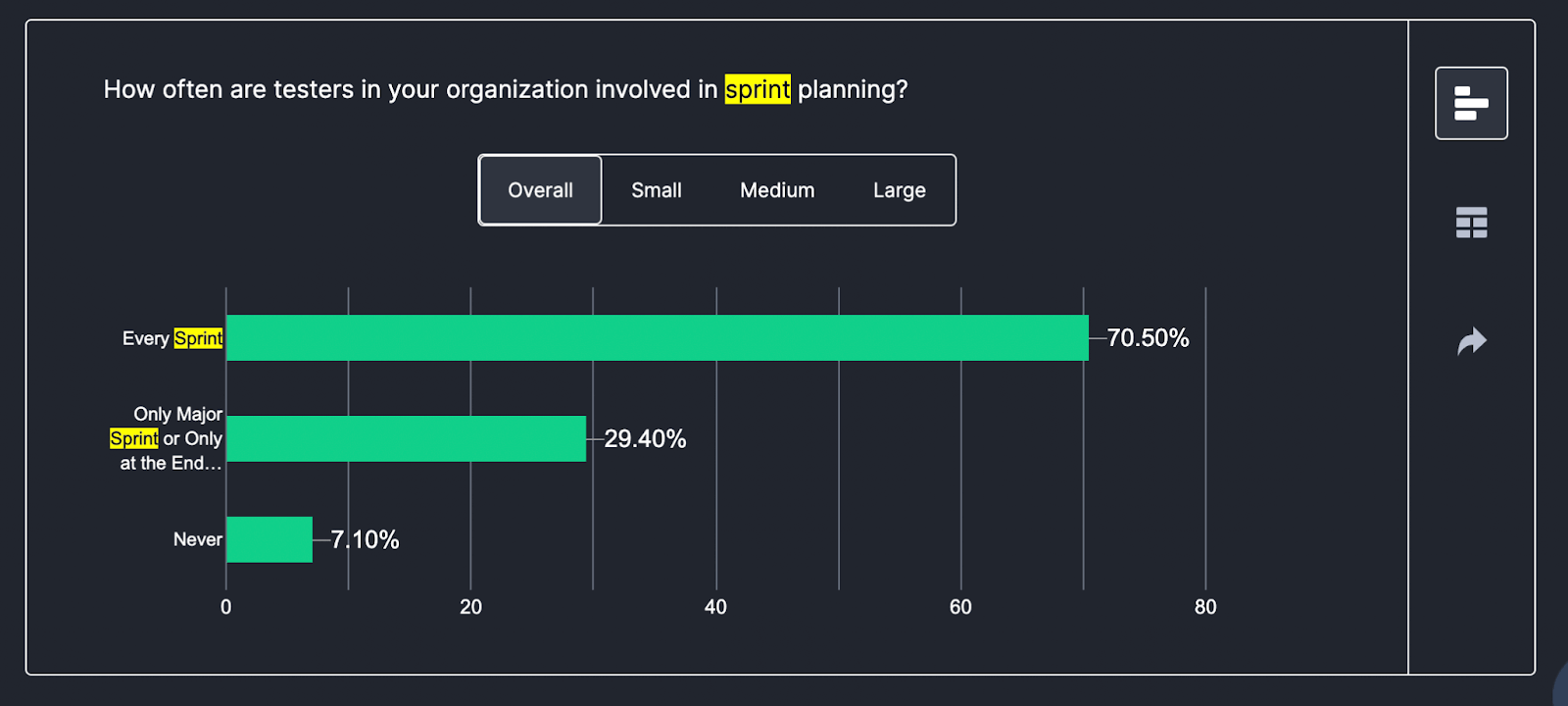The Rising Trend of Testers in Sprint Planning
Misba Kagad
Posted On: February 29, 2024
![]() 9884 Views
9884 Views
![]() 5 Min Read
5 Min Read
Agility is crucial in the dynamic realm of software development. Agile practices, play a strong emphasis on flexibility, teamwork, and quick iteration, and has completely changed how teams approach projects. The sprint, a focused period of time for delivering particular features or upgrades, is the foundation. Additionally, there is a notable change that takes place in the sprint planning process as test engineers are becoming more involved day by day.
The Increasing Involvement of Testers in Sprint Planning
According to the most recent LambdaTest survey, a shocking 70.5% of firms actively involve testers in every sprint planning, demonstrating that incorporating testers into sprint planning sessions is becoming mainstream practice. This percentage rises even higher in large businesses, where 74.4% of businesses give priority to having testers involved in each sprint. These numbers highlight a crucial shift in mindset—one that acknowledges the pivotal role of quality assurance in the software development lifecycle.

The Importance of Tester Participation
It is impossible to overvalue the importance of this trend. In the past, testing was frequently confined to the final stages of development and was not considered to be a part of the planning or implementation stages. These silos, however, have been broken by the emergence of agile techniques, which acknowledge that quality ought to be a fundamental component of the process rather than an afterthought.
Why in particular tester participation in sprint planning has increased so much? Iterating improvement and customer-centricity, two fundamental tenets of agile development, hold the key to the solution. Including testers from the beginning allows teams to take a proactive approach to quality assurance by providing priceless early insights into possible problems. Early defect detection not only reduces rework but also improves the quality of the final product, which in turn raises customer satisfaction.
Challenges in Integrating Testers into Sprint Planning
The LambdaTest survey data illustrates over 7% of companies continue to function without involving testers in sprint planning. The difference is even more noticeable in small businesses, as 10.4% do not involve QA teams in sprint planning meetings. Although there could be a number of explanations for this disparity, it highlights a critical area that needs to be improved. Companies must pay attention to the knowledge of testers during the planning stage in an era where software quality can make or break a business.
The reluctance to include testers in sprint planning can be attributed to a variety of issues, including misconceptions about testers’ roles, and a lack of awareness about the benefits they bring to the project. However, ignoring testers’ ideas and contributions during this critical time might result in poor outcomes, such as undetected faults, delayed releases, or poor customer satisfaction.
Involving testers in sprint planning is a strategic move to enhance the software qualityt, not just a way to check a box. It signifies devotion to provide best quality and a commitment to deliver customers with products that not only meet but also surpass their expectations. By fostering collaboration between developers, testers, and stakeholders from the outset, businesses pave the way for smoother workflows, faster delivery cycles, and, most importantly, superior end products.
Despite the complexities of incorporating testers into sprint planning, the long-term advantages significantly surpass the initial obstacles. Businesses that prioritize teamwork, communication, and a common commitment to quality can position themselves for long-term success in an increasingly competitive market setting. As software development processes advance, recognizing testers’ critical role in sprint planning becomes not only a strategic advantage, but a fundamental requirement for driving innovation and providing unique value to consumers.
Elevating Business Objectives Through Tester Involvement
There are several obstacles to completely integrate sprint planning. It demands a different cultural approach —a departure from the conventional, segmented method in favor of a more cooperative, cross-functional outlook. It requires open communication and consensus on objectives and goals. However, as the success stories of companies that have fully embraced this paradigm change demonstrate, the benefits far exceed the work.
Involving testers in sprint planning has advantages that go beyond quality assurance. Teams develop a sense of accountability and empowerment through promoting a culture of shared ownership and collaboration. With a focus on user experience, risk reduction, and product integrity, testers offer a distinct viewpoint to the discussion. Their insights not only point out potential risks but also encourage innovation and creative thinking, which promotes continual progress throughout the whole development lifecycle.
Benefits Beyond Quality Assurance
By providing testers with the opportunity to contribute in the sprint planning process, they can transform from mere validators to important contributors. The integration of testers into the entire product development lifecycle allows them to expand their skill set, gaining knowledge from requirements collection to deployment. This collaborative environment fosters the exchange of ideas, as testers closely work with developers, designers, and product owners to achieve common goals.
Allowing testers to contribute meaningfully throughout the product development lifecycle provides businesses with access to a variety of ideas and experiences, promoting innovation and knowledge sharing. This collaborative approach ultimately results in the development of more robust, high-quality products.
Conclusion
The increasing presence of testers in sprint planning indicates a shift away from traditional, outdated processes towards a more flexible, customer-focused strategy. Incorporating testers into sprint planning is not just a strategic need but a transformative shift with immense benefits for those willing to embrace it. This transformation is crucial in an era where success is predicated on quality rather than being an objective.
As organizations navigate through this landscape, solutions like LambdaTest seamlessly support and enhance the testing and development process. It stands out with its flexible testing environment, robust features, seamless integrations (e.g., JIRA, Slack), and scalable, cloud-based infrastructure, aligning perfectly with the industry’s shift towards quality-focused software development.
Got Questions? Drop them on LambdaTest Community. Visit now













